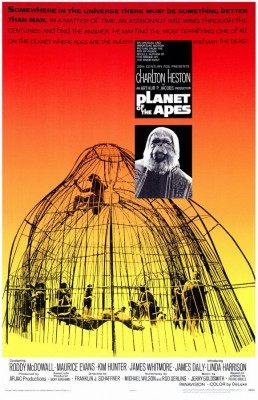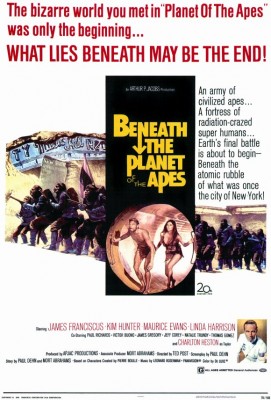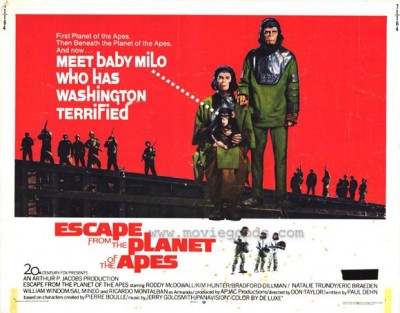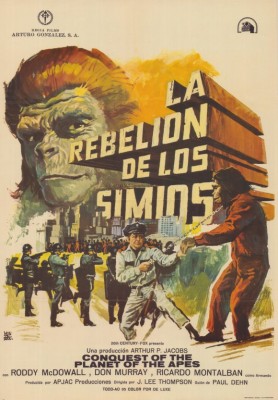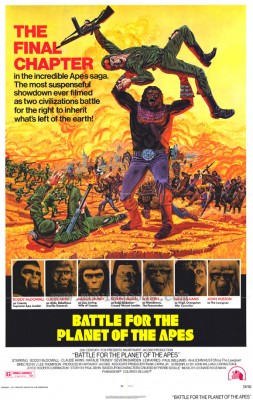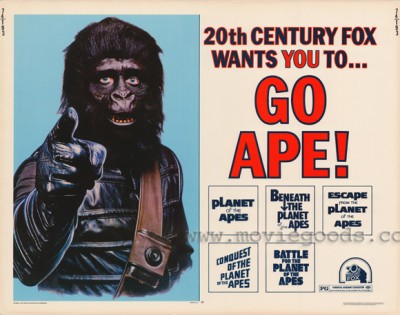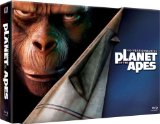| Reviews & Columns |
|
Reviews DVD TV on DVD Blu-ray 4K UHD International DVDs In Theaters Reviews by Studio Video Games Features Collector Series DVDs Easter Egg Database Interviews DVD Talk Radio Feature Articles Columns Anime Talk DVD Savant Horror DVDs The M.O.D. Squad Art House HD Talk Silent DVD
|
DVD Talk Forum |
|
|
| Resources |
|
DVD Price Search Customer Service #'s RCE Info Links |
|
Columns
|
|
|
Planet of the Apes - 40-Year Evolution (Planet of the Apes / Beneath / Escape / Conquest / Battle)
Better still, this set includes something not seen in more than 35 years: the vastly superior pre-release cut of Conquest of the Planet of the Apes, the Addio, zio Tom of Hollywood sci-fi. Until now, viewers had to content themselves with the still-powerful but heavily compromised theatrical release version. In an age when "Director's Cut" is rarely more than a marketing ploy, this one really is a game-changer.
But, for those who own all the movies on DVD already - and this collection presupposes a familiarity with the Apes universe (as does this review) - particularly the pricey but visually impressive Legacy Collection from 2006, is this set really worth it? Generally speaking, the answer is yes: the films look better than ever, though the viewer shouldn't expect them to pop off the screen like the Lowry-enhanced Dr. No and From Russia with Love, to name two recent examples. Most of the extras aren't new, and while much of the new material either doesn't offer much in the way of new information or is pretty dopey, it's well-made and valuable in its own way and it all looks fantastic in high-def. The handsomely designed book, with its imaginative layout and beautifully reproduced illustrations is worth a big chunk of change all by itself and the original cut of Conquest, as much as the high-def transfers, ultimately puts this over the edge.
Beware the beast Man, for he is the Devil's pawn. Alone among God's primates, he kills for sport or lust or greed. Yea, he will murder his brother to possess his brother's land. Let him not breed in great numbers, for he will make a desert of his home and yours. Shun him; drive him back into his jungle lair, for he is the harbinger of death.
Imagination is everywhere in Planet of the Apes. So famous is the film today, so engrained are its images and bits of dialogue ("Take yer stinkin' paws off me, you damn dirty apes!") that it's easy to forget how utterly flabbergasted mesmerized audiences were when it was first released (or, as many impressionable children first experienced it, during its famously successful primetime network television airings in the early-1970s). In early 1968, with both Stanley Kubrick's 2001: A Space Odyssey and Planet of the Apes in theaters, science fiction cinema suddenly had come of age. It wasn't just that, compared with nearly everything that had come before it, both films were so technologically advanced in their special effects and innovative make-up designs. No, these were poetic, intellectually challenging movies made for adults. In both cases, the filmmakers drew upon the latest technology and every type of cinematic trickery and storytelling device they could think of, harking as far back as the early silent era. These were movies built from the ground up.
For Planet of the Apes, the story of a time-traveling astronaut, Taylor (Charlton Heston) trapped in a far-off world where intelligent talking apes dominate and humans are mute primitives, innovation is everywhere. It surmounts budgetary limitations by visual and aural suggestion rather than explicit literalness. (How refreshing it is to see a science fiction movie without CGI landscapes and cities!) The outstanding direction by Franklin J. Schaffner and work of cinematographer Leon Shamroy, using foreboding, barren locations in Utah (and the Fox Ranch in Malibu), successfully convey an alien world in myriad ways. There are extreme aerial and long shots where Taylor and his fellow astronauts are like isolated ants on the burning landscape (the advantages of high-def come into play here), shaky hand-held camerawork to show their perspective and to convey desperation, dramatic (and not an over-) use of the zoom. A disorienting strangeness permeates the film: the inexplicable thunder and lightning, the X-shaped scarecrows (the high-def clarity makes their purpose more apparent), the disorienting use of only dark brown and black horses by the Apes' cavalry, the strange architecture of Ape City, etc. This pervasive strangeness also helps to distract viewers away from various issues that go unanswered, such as the Apes' ability to read and speak perfect English, or how Taylor's mission of colonization begs the question: The (doomed) female astronaut is pegged as "the new Eve," but wouldn't it have made more sense to send three women and one man instead of three men and one woman?
Early scenes especially cleverly avoid the pitfalls of the genre. For instance, the crash landing of Taylor spacecraft is viscerally powerful but also notably abstract and subjective, while Schaffner's careful balance of silence, underscoring, and extremely good dialogue (by Rod Serling and Michael Wilson) establishes Heston's misanthropic character and the film's setting with perfection.
Jerry Goldsmith score, one of the best in all of cinema, is equally alien and orchestrated with unusual instruments. Watching the film here for the umpteenth time, I noticed something I never had before: Goldsmith's title cue prominently features a surf-like riff that neatly bookends the very end of the film, the haunting sound of waves pounding an isolated beach as Taylor, in the words of orangutan Dr. Zaius (Maurice Evans) finds "his destiny." The effect is repeated in the opening titles of Beneath the Planet of the Apes.
That Planet of the Apes, unlike 2001 was also embraced as mainstream entertainment, as a sci-fi / action / thriller that never lets up, brought it its popular appeal. Indeed, it's among the very few 40-year-old movies that very nearly haven't aged at all.
The film reinvented Charlton Heston's screen persona, from an actor specializing in larger-than-life historical and religious figures into a cynical loner-hero. It's one of the great performances of a time rife with such characters, comparing favorably to William Holden in The Wild Bunch and many others. The Ape-actors are uniformly excellent, well-cast for their distinctive voices (McDowall, Evans) and expressive eyes (Kim Hunter). The characters are all fully-formed in interesting ways: McDowall's Cornelius is amusingly cynical and skeptical, a far cry from the cuddly one he'd become (and personally prefer) in the disappointing 1974 TV show. Evans's is a great character, the Ape culture's Minister of Science and Chief Defender of the Faith, the wise old ape who sees trouble from the beginning, who's not amused by "Bright Eyes'" (the name given Taylor by his captors) and his mimicking tricks. Of course, Planet of the Apes is chiefly an allegory about mankind's contrary nature, and especially as personified by Dr. Zaius, the contradiction between religious faith and science. (*****)
General Ursus: "The only good human is a dead human!"
Astronaut Brent: "This is a bloody nightmare!"
The unexpected gargantuan success of Planet of the Apes - at a time when virtually everything else 20th Century-Fox made lost money, and a lot of money at that - guaranteed a sequel. Like many of my generation I discovered the Apes films during their network television debuts in 1973 and '74. Back in those pre-cable/pre-VCR days the television premieres of Hollywood blockbusters was a Big Deal scoring huge ratings (Apes reportedly was seen in 22 million homes). While perhaps none of the sequels measured up to the first film my generation, discovering these films on TV, was absolutely mesmerized regardless.*
One watches the sequels today with simultaneous nostalgia and disappointment that none quite lives up to the full potential of consistently intriguing concepts. Almost every problem with the sequels can be traced back to the ever-dwindling, absurdly inadequate budgets the sequels had to work with. Too many corners are cut, the productions show obvious signs of having been rushed, second-rate talent fill key positions, and screenplays in need of nurturing are put into production before they're ready. I love 'em all, but where Planet of the Apes is practically perfect, it's hard to watch any of the sequels and not cringe at all the cost-cutting.
Case in point: Beneath the Planet of the Apes. According to director Ted Post, this started out as a $5 million production - adequate given that many of the sets and costumes from the first film could be reused - but then the budget was slashed to $2.5 million, just about what Irwin Allen's Five Weeks in a Balloon had cost in 1961, and less than half the cost of the notorious Myra Breckinridge, released that same year!
Unfortunately, the cheapness shows all over the place. For Apes, the filmmakers went on location to Utah; for Beneath, everything is shot on the Fox Ranch in Malibu, or in and around Red Rock Canyon, a two-hour drive from Century City and an overly familiar movie location eclipsed only by Bronson Caverns and Vasquez Rocks.
The other insurmountable problem with Beneath was that Charlton Heston refused to star in the sequel, agreeing only to do a cameo at the beginning, later amended so that he appears briefly at the start and then comes back for the climax. This necessitated building the screenplay around another astronaut, Brent (James Franciscus), who has no option but to retrace Taylor's steps. All this gives Beneath its incredibly awkward structure (also relying on some extraordinary coincidences and contrivances**), and it's not until the picture's second-half that it finally starts to get interesting.
At its best Beneath approaches the otherworldliness of the first film: Brent, accompanied by mute human Nova (Linda Harrison), discovers the buried remains of Manhattan beneath the Forbidden Zone as the atomic bomb-worshipping telepathic human mutants lure him to their secret city. It's all wonderfully mysterious and atmospheric; Brent and Nova walk past the ruins (optical matte shots and/or on-set glass paintings) of Radio City Music Hall, the New York Stock Exchange, and so forth. The sets of a half-buried Grand Central Terminal and St. Patrick's Cathedral (in fact, redressed sets from Hello, Dolly!) are very impressive, and the revelation about the mutants ("I reveal my inmost self to my maker") was quite shocking in 1970. How the first three Apes films landed G-ratings is beyond me.
Also good, despite the inadequate budget, is a scene with war-mongering General Ursus (James Gregory, very good) and his gorilla army marching on the Forbidden Zone, where they find crucified gorilla soldiers helplessly suffering in a whirlwind of flames. Then, out of nowhere, a colossal statue of the Lawgiver (the simian equivalent of Christ) appears, blood dripping from its eyes and mouth.
Unfortunately, captivating moments like these are undercut by thudding literalness elsewhere, clumsy attempts to draw parallels to 1970 America. Ape "hippies" (as described in some of Fox's promotional material) protest the gorillas' militarism, for instance, and the vaguely anti-nuclear message at the end is muddled. Indeed, the science vs. faith theme so intelligently explored in Apes is sloppily expressed here, despite some cleverness with the mutants' darkly comic scripture. The character of Dr. Zaius (Maurice Evans again) is all over the map here; inexplicably, Zira (Kim Hunter) positively adores him now.
In fairness to Ted Post, perhaps he doesn't deserve all the blame for the film's unimaginative direction given the reduced budget and schedule. Nevertheless, too many scenes are shot with zero flair and standard coverage: wide establishing shot, medium 2- and 3-shots, close-ups of the actors for dialogue and reactions. The rushed production results in some incredible sloppiness. A scene between Ursus and Dr. Zaius in an ape sauna opens with a shot of a gorilla extra whose pink forearm is clearly visible between the sleeve of his gorilla "arm" and made-up ape hand. Throughout the film are bad angles of the ape actors that reveal their teeth and lips behind the latex ones.
James Franciscus isn't a bad actor; he's earnest and intelligent, though as Brent he tends to pant his way through scenes. The problem is that he just doesn't have a character to play; it's one built entirely off of reacting to what's going on around him. By the end of the film we know less about him than doomed astronauts Dodge and Landon in Planet of the Apes.
And yet the film has a certain power; as a child I thought it was almost if not quite as good as the original (an opinion generally shared by 1970 audiences). It's exciting and, ultimately, deserves credit for trying to move the story in new directions, and for the most part successfully introducing new cultures, new concepts. But it could've been so much better.... (***)
Committee Chairman: "Does the other one talk?"
Cornelius: "Only when she lets me"
Though in some respects the most dated of the five films, Escape from the Planet of the Apes has a much better script than Beneath while its scaled back ambitions production-wise are in line with its very modest budget.
As good as the basic story is, its premise is awfully hard to swallow: it seems that just before the earth was destroyed in a nuclear fireball in 3955 A.D. (at the end of Beneath), chimpanzee-scientists Cornelius (Roddy McDowall), Zira (Kim Hunter), and the vaguely de Vinci-esque Milo (Sal Mineo) somehow a) located and salvaged Taylor's spacecraft from the bottom of a lake in the middle of the Forbidden Zone; b) got the power back on; and c) successfully launched it back into space (!), where it was thrown into a convenient time warp sending it back to earth in 1973 (two years into the future when Escape was in theaters). That's quite a leap for apes amazed by a simple paper airplane in the first picture.
Nevertheless, Paul Dehn's screenplay cleverly turns the original film's story on its head, with Cornelius and Zira reversing roles with Taylor. Now they're seen as a threat to the future of mankind, in a world where humans are intelligent and apes are primitive. (Milo, minutes after being introduced and with no opportunity to develop any character, is strangled by a wild gorilla, or rather a man wearing an incredibly phony gorilla costume. It's about as realistic as the skin used in King Kong Escapes.) Somewhat peculiarly, when Zira confesses to everyone's horror that she dissected and experimented on humans, it's pointed out that man does many of the same experiments on "beasts." Why not say apes? This one's also got some deftly introduced biblical references that, rare for such things, actually work.
Somewhat reminiscent of the spirit of Pierre Boule's original novel, Cornelius and the by now pregnant Zira become media celebrities - while behind closed doors the government wonders what to do with them. Dr. Otto Hasslein (Eric Braeden), Senior Scientific Advisor to the President (William Windom), assumes Dr. Zaius's position in the story, where quickly but believably he becomes convinced that the long-term survival of mankind hinges on getting rid of Cornelius and Zira's offspring: "Later we'll do something about pollution. Later we'll do something about the population explosion. Later we'll something about the nuclear war. We think we've got all the time in the world, but how much time has the world got?"
Braeden and Windom are terrific in a couple of scenes together. "Herod tried that," says the president, "and became historically unpopular."
"We condoned the attempted assassination of Hitler because he was evil," Hasslein counters.
"But would we have approved killing him in babyhood when he was still innocent?" argues the President. "Or killing his mother when he was still in her womb? Or slaughtering his remote ancestors?"
There are other neat touches. A filmed prologue with the three apes in space, watching the earth destroyed in 3955, wisely was dropped in favor of a new opening, with Taylor's ship suddenly found floating off the coast of California. Perhaps accidentally, the opening shot of the shoreline is nearly identical to shots of the shoreline in Apes and Beneath (all appear to in fact be different beaches in Malibu). When a helicopter flies into the shot from behind some cliffs it's a neat little surprise.
Beyond Dehn's script, the core of the film's success is the incredibly sympathetic and believable performances of Roddy McDowall and especially Kim Hunter. They may be apes, but they're also a devoted, loving couple and their scenes have a charm and poignancy unique to the series. The film keeps the story focused on their plight and the characters they create keep it compelling and, ultimately, heartbreaking. Bradford Dillman and Natalie Trundy are less interesting as their human counterparts, though Braeden, almost a movie star in 1971, makes an unusually logical and methodical antagonist, while Ricardo Montalban is a delight as salt of the earth circus owner Armando. (Also in the film is cult local news anchorman Bill Bonds, a real Howard Beale type, playing himself in an interview scene with Hasslein. Escape from the Planet of the Apes frequently aired on WXYZ-TV's "4 O'clock Movie," followed by the evening news with Bonds. His co-anchors often chided him with lines like, "Hey Bill, any more news on them apes?")
The movie is not without its faults. Beside that groan-inducing gorilla suit, the script relies on Zira not being able to keep her mouth shut, the loosest lips in Ape City. Director and former actor Don Taylor seems to have worked well in shaping the performances while his flat visual style is somewhat offset by Joseph Biroc's lensing. Leonard Rosenman had, uh, "aped" Jerry Goldsmith's style for Beneath with mixed results but Goldsmith himself came back for Escape, another fine score.
Guard: "They're a bit uppity"
Of all the Apes sequels, TV shows and remakes, only Conquest of the Planet of the Apes approaches the greatness of the original film. Stylistically it's quite different, and the intellectual pursuits of the first film are replaced with a numbing Orwellian oppressiveness that gives way to unbridled rage. From a production standpoint Conquest is nothing short of miraculous: produced for just $1.6 million, about $400,000 less than Escape, it's a large-scale epic made for peanuts, not much more than a made-for-TV Movie of the Week. All-told, it's an incredible achievement for all concerned, especially director J. Lee Thompson.
In 1991, Circus owner Armando (Ricardo Montalban) and 18-year-old Milo (Roddy McDowall) find themselves in a fascist, totalitarian America where apes have become slaves to mankind. Milo's ability to speak has been kept under wraps, but when he blurts out "Lousy human bastards!" as Gestapo-like thugs beat a helpless gorilla, Milo flees and Armando is arrested.
He's taken before self-loathing Governor Breck (Don Murray), a real Hitler-type convinced Armando may have been hiding Cornelius and Zira's intelligent offspring. He's interrogated by Chief Inspector Kolp (Severn Darden) while, to avoid capture, Milo loses himself in an incoming slave shipment, where his unusual intelligence eventually lands him a high price at auction. Ironically, he's purchased by none other than Governor Breck, buying slaves for his Command Center. Given the slave name "Caesar" (which Milo chooses himself out of a book of Shakespeare's plays) the talking chimpanzee secretly plots an ape revolt.
Conquest of the Planet of the Apes draws obvious parallels to the race riots of the mid- and late-1960s, and the film's extreme violence gave Fox executives - worried that the film would get an "R" rating and thus limit its box office - got cold feet. They cut the most explicit violence out and reworked the end of the film, suggesting the Apes would show far more compassion for the former owners than they had for them.
For the first time, Fox's Blu-ray offers both the theatrical release and the pre-release version. The original cut is a revelation. The differences are slight, but they make all the difference in the world. In the uncut version, the revolt is much bloodier, on both sides. There are numerous close-ups of both humans and apes getting shot in the head, while the apes are seen more explicitly mutilating the bodies of dead police officers, or in large numbers stabbing and beating them to death. In this version, when the Apes close in on the Command Center (while inside a frantic Breck shoots a Gorilla in cold blood) there's an awesome feeling of dread lacking in the theatrical version.
(Spoilers): The original ending is infinitely more powerful: No speeches about putting away hatred, putting down weapons, dominating humans with compassion and understanding. No siree. Here the Apes pile the dead and half-dead bodies of Breck's police force in a heap of bloody pulp as Breck himself awaits his comeuppance. What was shocking in its cut form is numbing here. It's almost sad; had this version been released, well, it just might have incited a riot or two of its own, but the film might be remembered more along the lines of A Clockwork Orange than just another Apes sequel. Fans of these films watching this version in 2008 are going to find it fascinating, but how shell-shocked preview audiences must have been in 1972!
There wasn't money in the budget to build much in the way of futuristic sets, but the filmmakers solved this problem ingeniously: they simply walked the unit across the street and shot most of the picture at the Century City Shopping Center and the area between the Century Plaza Tower and the Century Plaza Hotel, all of which had once been part of the Fox backlot.*** The austere, ultra-modern architecture has an air of oppressiveness all its own, and there is an eeriness during the nighttime scenes with the greenish fluorescent lights from the skyscrapers dispassionately watching over the melee below.
Though the film relies on the same cost-cutting use of masks for some of the background extras, the cheapness of the production is less obvious than on Beneath and Escape. A brief scene with Caesar hiding with three Orangutans uses costumes far superior to the gorilla suit seen in Escape, though McDowall's chimpanzee skin is unconvincing.
McDowall delivers another fine performance, especially when you consider how believable he makes Caesar's monumental character arc. Perhaps not deliberately, Montalban's Armando is played much more darker than in Escape. There he was given to extravagant gestures and typical Latino machismo, but here he's a frightened man - they make an interesting contrast. Don Murray went to the trouble of rehearsing his lines in German (!) to get in touch with his character's Nazi-like quality ("That's why Julius Caesar is fantastic in German," he explains, "and why Romeo & Juliet is terrible!") It's a wonderfully snarling, blood-in-the-face performance.
The real surprises though are Severn Darden, former Second City comedian, as the sadistic, Himmler-like Kolp, performed in an unsettlingly emotionless manner; and African-American actor Hari Rhodes as MacDonald, Breck's single humanist aide who sympathizes with Caesar's plight. They have only a few brief exchanges, but these are very well-written and performed.
Also worth noting is Bruce Surtees' excellent cinematography and Tom Scott's pounding score (buttressed by some stock Jerry Goldsmith cues). I'm not sure but the unrated version seems to use some different underscoring during the rioting scenes. Theatrical Version: (****) / Uncut Version: (**** 1/2)
Mendez the Mutant: "Somewhere along the line of history this bloody chain reaction has got to stop. A destroys B, B destroys C, C destroys A and is destroyed by D, who destroys E"
...and Battle for the Planet of the Apes destroys the franchise. To be fair and to paraphrase wise old Dr. Zaius, its outcome was preordained. The film went into production with its producers knowing it would be the last, that a weekly TV series for CBS was to follow during the 1974-75 season - though as things turned out the show didn't even last till 1975, much less 3955 A.D.
As imperfect as the first three sequels are, each has an intriguing concept and many other elements in their favor, and they're all admirable for moving the series in new directions. Visually and in terms of story, none is quite like any of the others. But Battle for the Planet of the Apes more closely resembles the depressingly unambitious TV series than the preceding movies, worse in a way: the TV show has excellent production values for such things, but the movie is at times ludicrously cheap. The epic battle of the title consists of about 50 apes and all of 30 mutants (driving a couple of Jeeps, a school bus and, of all silly things, a Buick). Of course, calling your picture Minor Skirmish on the Planet of the Apes isn't likely to sell many tickets.
Worse, the screenplay by John and Joyce Corrington (The Omega Man) is quite bad, full of clunky exposition, sloppy sentimentalism, inapt religious parallels (mainly to the story of Cain and Abel) and occasionally oddball concepts. This is certainly the only Apes film in which a pet squirrel plays an integral part of the plot. After Conquest, Fox and producer Arthur P. Jacobs wanted a family-friendly G-rated film, and boy howdy that's what this is: there's some heavy-handed moralizing in a school setting akin to Little House on the Prairie, and tree houses resembling Disneyland's Swiss Family Robinson attraction.
The picture actually opens in the year 2670, where the Lawgiver (John Huston, singularly unenthused) looks into the camera to tell the tale of Caesar's reign centuries before. More than 12 years have passed since the events in Conquest, and during the interim mankind has somehow decimated its cities in a global nuclear conflict that inexplicably has spared the Eden-like proto-Ape City, a mere three day's walk from the melted, radioactive ruins of city from Conquest.
Caesar (Roddy McDowall, natch) is intrigued by heretofore withheld (why?) information from McDonald (Austin Stoker, playing the brother of Hari Rhodes's character) that video and audio tapes of his parents may still exist in the ruined city's archives. Caesar rather selfishly puts together an expedition consisting of himself, McDonald, and intellectual orangutan Virgil (Paul Williams - yes, the). Meanwhile, gorilla Aldo ("that's General Aldo!"), played by Claude Akins, is just itchin' to kill humans and overthrow Caesar, stirring up trouble throughout the picture.
In the future Forbidden City Caesar, McDonald, and Virgil discover a society of mutants led by Former Inspector Kolp (Severn Darden), now acting governor. (His radiation-scarred army are the antecedents of the creatures in Beneath.) Kolp decides to wipe out the Apes in a final battle. Meanwhile, Aldo critically injures Caesar's son, Cornelius (Bobby Porter), who had overheard the gorillas' plans for a military coup.
Virtually nothing about Battle for the Planet of the Apes works. Director J. Lee Thompson tries to liven things up with oblique angles and brisk cutting of the action scenes to hide their threadbare nature, but the odds are too much against him. In contrast to Conquest most of the film takes place in broad daylight, and the lush greens of the visually uninteresting section of the Fox Ranch chosen for the picture work against it. The cheapness of the film is too apparent amid all this sunshine. Similarly, the Forbidden City is represented by a poor matte painting and colorless industrial interiors, though there's an interesting exterior set of the half-melted city that resembles the rubble of Hiroshima and Nagasaki.
Though Darden makes an amusing villain, Akins' Aldo is just a big dumb ox, a gorilla Mike Mazurki. Had the character been as politically savvy and intelligent as James Gregory's General Ursus, the conflict between Aldo and Caesar might have been more interesting. Virtually the only thing original about the picture is some amusing banter between Virgil and fellow orangutan Mandemus (Lew Ayres), keeper of the Apes' armory and "Caesar's Conscience." Needing guns for their trip across the desert, Caesar, Virgil, and McDonald must reason with the logical ape before he'll give them access to the guns. The dialogue is amusing and offers an all-too-brief glimpse at the orangutan subculture of ape society, which the film could have used a lot more of.
The Blu-ray disc includes both the original theatrical version and an "extended version" that apparently debuted when Battle made its network premiere in 1974. Unlike Conquest, Battle's extra footage is very minor and doesn't help the film substantively. The main difference is two extra scenes that expand female mutant Alma's (France Nuyen) character. She's charged by Kolp to launch the Alpha Omega doomsday bomb (from Beneath) should the apes emerge victorious, a task she debates with Mendez (Paul Stevens), founder of the mutant's bomb-worshipping religion. Both Versions: (**)
Video & Audio
The Apes films were all shot in anamorphic wide screen (all in Panavision except Conquest, which was Todd-AO 35) and, rather surprisingly, all were originally released mono. (Some sources insist the first Apes was released 4-track mag in some markets, but this seems erroneous.) Planet of the Apes looks a bit soft, Beneath looks a little better, and Escape looks fantastic. Why this is I have no idea. Could Planet of the Apes been mastered from an inter-negative while Escape's came directly from the original camera negative? Or is it because of improvements in anamorphic lenses, film stock and printing between 1967 and 1971, or something else entirely? Apes certainly looks as good as I've ever seen it, including a 35mm screening at the American Cinematheque a few years ago. It looks nice but in no way does it pop off the screen the way Escape does.
On Planet of the Apes, one can finally read the main title card that was completely washed-out by the glare of a passing comet (or something), and other details previously visible only in 35mm theatrical prints come into focus here. This does have some interesting disadvantages, however; it's clear for instance in some shots that the interiors of Taylor's spaceship are constructed out of plywood. Plants are visible in a few high-angle shots before we're supposed to see any plant life, and in Ape City some of the structures off in the distance are clearly two-dimensional standees.
The colors are subdued but then they always were, though on Blu-ray arguably even more so. The transfer leans toward yellows and browns, but other details (such as the green of Taylor's spaceship) are brought out more then in the past. Probably due to over-printing (this is a hugely popular title, after all) there's some visible scratches and speckling, though nothing actually distracting. Some DNR is obvious here and there, particularly during a day-for-night scene, but all but invisible most of the time. Matte shots and other opticals are improved; one of Heston riding along the shoreline was necessary, otherwise he'd be seen heading for the Santa Monica Pier!
Some have criticized Conquest's transfer as being grainy, but I think this is inherent with the way the film was shot. My guess would be that, because so much of the film is takes place at night, in low-light, night-for-night situations, the filmmakers may have opted for a faster film stock to be used throughout the film, which would necessarily be a bit grainer. That said, I found the fine grain of the Blu-ray transfer to be rather pleasing to the eyes, and the grittiness of it in keeping with the mood of the film. All told, the transfer is as good as Escape's; it's just that the film stock itself is grainier. Escape and Conquest benefit most in high-def; for reasons difficult to explain, the clarity of the transfers make the films themselves look slicker and less cheap. Battle, in contrast, looks shoddier than ever. Apparently both Conquest and Battle use seamless branching for the two versions on each disc. On my player Conquest played just fine but briefly froze up twice during Battle.
The films are presented in 1080p/AVC MPEG-4 format on five BD-50 dual-layered discs, one per film regardless of the amount of extras and alternate cuts. The fold-out box design is attractive but the discs are on those annoying rubber hubs. The discs aren't that hard to remove, but getting them back on the hubs is extremely difficult. The menu screens are imaginatively designed and easier to navigate than Fox's Bond discs.
Audio-wise, the films get DTS-HD Lossless Master Audio 5.1 treatment, but little about it is impressive. I expected more directionality from the sound effects and strong separations in the underscoring but there was little of either. It's been years but I remember quite liking the Chase stereo remixes done around the time of the laserdisc releases. These seem bland by comparison. Each film includes a "D-Box" audience participation option that seems appropriate (as pal Gary Teetzel points out) for something like How the West Was Won, Earthquake or The Tingler but not for Apes. As he put it, "Boy, that could be annoying! Can it simulate the sensation of being hit by a high-pressure hose during the 'It's a madhouse' scene?" Or maybe a tingling sensation all over during Caesar's expedition into the highly radioactive Forbidden Zone?
Alternate Spanish mono tracks accompany all five films. French audio is 5.1 Dolby Digital on Planet of the Apes and Battle, Dolby Surround on Beneath andConquest, and mono on Escape. Optional subtitles in English, Spanish, Cantonese, Mandarin, and Korean are included.
Extra Features
The movies are preceded by CGI-animated Lawgiver Introductions. Some insist that whoever's doing the voice isn't imitating John Huston (who played the character in Battle for the Planet of the Apes) but they're wrong: it's simply a bad imitation of Huston. (Too bad Robert Mitchum is dead; he did a great Huston imitation.) Instead of going to all the trouble to create this tongue-in-cheek animation, it might have been a better idea to actually make up an actor in the style of the original Apes, as was done when the television series was reworked into pseudo-features and aired with new introductions by Roddy McDowall (donning the latex for the last time, I'd imagine). Better still, why not invite someone like Oscar-winning makeup artist Rick Baker to demonstrate how the makeup was created and applied?
There are a ton of extra features, though like Fox's Bond discs, most are supplements created for previous DVD incarnations. Except for the photo and advertising galleries, all of the previously-available supplements are in standard-definition and have not been remastered. The older material includes:
Planet of the Apes: Audio commentary by Actors Roddy McDowall, Kim Hunter and Natalie Trundy, and Makeup Artist John Chambers; audio commentary by Composer Jerry Goldsmith; text commentary by Eric Greene, author of Planet of the Apes as American Myth; Behind the Planet of the Apes Documentary; Original Makeup Test with Edward G. Robinson (1966); Roddy McDowall's On-Set Footage; Dailies and Outtakes (no audio); N.A.T.O Presentation (that's the National Association of Theater Owners, in case you were confused); Vintage Planet of the Apes Featurette (1968); Teaser Trailer and photo gallery. All of this material is standard-def (except for the gallery) and has not been remastered.
Beneath the Planet of the Apes: Trailer and gallery
Escape from the Planet of the Apes: Don Taylor Directs "Escape from the Planet of the Apes; trailer and gallery
Conquest of the Planet of the Apes: A Look Behind "The Planet of the Apes" (1972); J. Lee Thompson Directs "Conquest of the Planet of the Apes; trailer and gallery
Battle for the Planet of the Apes: Trailer and gallery
Of all this material, by far the best is Kevin Burns and David Comtois's definitive 1998 documentary, Behind the Planet of the Apes, an exhaustive, 127-minute show rife with great interviews, anecdotes, archival documents and rare footage. Sadly, many of the interview subjects have since passed away: Roddy McDowall (who died soon after it aired), Kim Hunter, Charlton Heston, make-up designer John Chambers, directors Don Taylor and J. Lee Thompson, and on and on.
The New Stuff:
First, the imaginatively designed book: written by Lee Pfeiffer and Dave Worrall, Planet of the Apes - 40-Year Evolution is a hardcover, 200-page book in full color. It's well written but primarily interesting for its visual appeal, as it's crammed with glossy photographs, conceptual art, and advertising material. In the back of the book are photographs of original props and makeup appliances as they exist today, and a full list of movie credits. It's very impressive.
Each movie comes with a new, high-definition featurette running 16-23 minutes. While they add very little that isn't already covered at length in Behind the Planet of the Apes, they're very entertaining and look great. Stylistically, they seem to have been inspired by the documentary Easy Riders, Raging Bulls. James Brolin, who played Cornelius in 1966 makeup test footage, narrates the featurettes, which include new interviews with ancient columnist (and Curd Jürgens look-alike) James Bacon, perhaps the only person to appear in new footage in all five films; Ted Post, Linda Harrison, Don Pedro Colley ("We don't kill out enemies, we make our enemies kill each other"), Sean Emmett (Kim Hunter's son), makeup artist Daniel Striepeke, Tow Lowell (friend of Roddy McDowall, who played the orderly in Escape), Don Murray, cinematographer Richard Kline, actor Noah Keen (the teacher in Battle), Austin Stoker, Bobby Porter, and, strangely enough, Angela Lansbury (talking about McDowall's early career).
Despite a few minor issues - at one point the narration refers to Rex Harrison and Anthony Newley while showing a photograph of Harrison with a chimp! - these are very nicely done. The one on Escape becomes a kind of tribute to blacklisted actress Hunter, while another pays homage to McDowall. There's footage of McDowall (in full Ape makeup) appearing on The Carol Burnett Show and a few other surprises. I especially liked a brief segment showing how Fox recycled props and costumes from one Ape film to the next.
The Planet of the Apes disc also features a tongue-in-cheek but clever Public Service Announcement from ANSA outlining Taylor's mission. It's well-done but personally I wish Fox would have channeled all that energy and expense into licensing and clearing the use of other material that would have been ideally-suited to the Blu-ray format, such as including the "Power Records" / comic book adaptations (I had those!) which were both exciting and hilarious. Similarly, I'm surprised Fox didn't include in their entirety The Simpsons and Futurama "Apes" spoofs considering Fox co-owns both shows, or that they didn't license a Blu-ray reproduction of the famous Mad magazine versions ("The Planet That Went Ape," as I recall).
Also included is a fun look at The Impact of the Apes, rightly noting the influence of the theatrical release, reissues, and original network airings, and all the merchandising that followed, including Model kits, action figures, jigsaw puzzles - you name it.
Science of the Apes is a "picture-in-picture" video commentary focusing on the scientific aspects of time travel and whatnot. Thankfully, it's viewable separately from the feature. Beyond the Forbidden Zone is a very dubious extra, a BD-Java video game of almost zero interest.
Parting Thoughts
This is a great set. If you've passed on getting home video versions of the films up to now, this is the one to get. If you've been buying each new set as it comes along, your frustration at having to double-/triple- dip is understandable, but the new transfers, new supplements (especially the book) and, most importantly, the revelatory uncut version of Conquest combined make it worth its admittedly high price. A DVD Talk Collectors Series Title.
* Battle for the Planet of the Apes didn't air until 1974. I remember being enormously excited by the promo film that ran at the end of a re-run of Conquest - but then my parents insisted I go to my Boy Scouts meeting that evening. I glumly sat there dreaming about how terrifically exciting Battle must be. Little did I know.
** Why in heaven's name does Taylor advise Nova to "find Zira" should anything happen to him? Yeah, great advice - like telling a lost calf to head straight for the slaughterhouse.
***When MGM moved from Santa Monica to a new skyscraper in Century City, one of the few benefits for this reviewer was being able to prowl around the area during lunch, finding the exact spot where various scenes had been filmed. Most of it was relatively unchanged in 2003, but just as I was moving to Japan much of the area was undergoing extensive redevelopment.
Film historian Stuart Galbraith IV's latest book, The Toho Studios Story, is on sale now.
|
| Popular Reviews |
| Sponsored Links |
|
|
| Sponsored Links |
|
|
| Release List | Reviews | Shop | Newsletter | Forum | DVD Giveaways | Blu-Ray | Advertise |
|
Copyright 2024 DVDTalk.com All Rights Reserved. Legal Info, Privacy Policy, Terms of Use,
Manage Preferences,
Your Privacy Choices | |||||||









